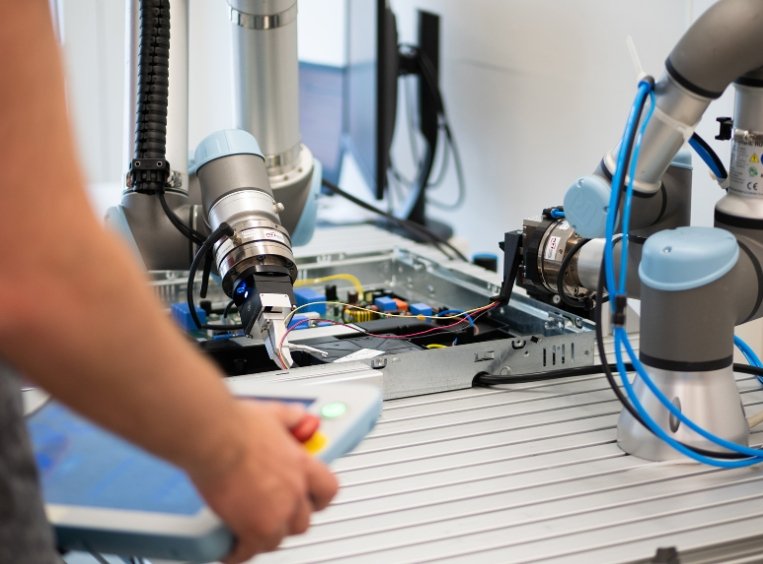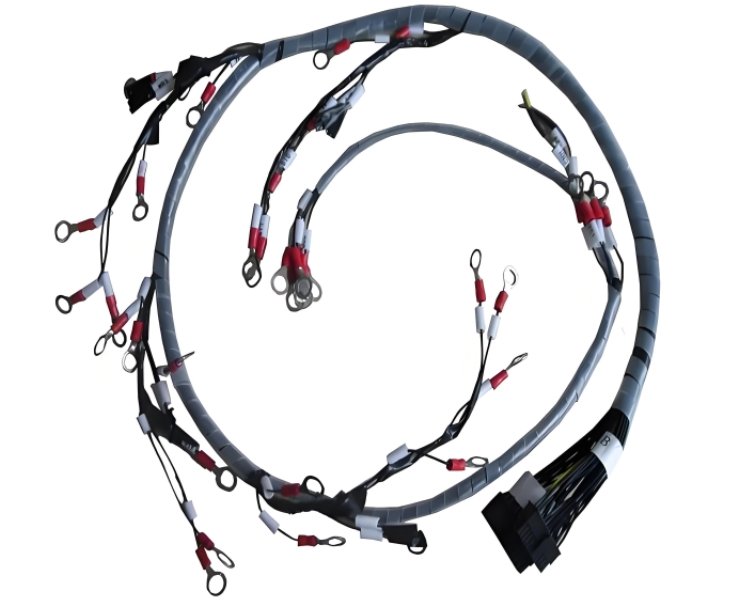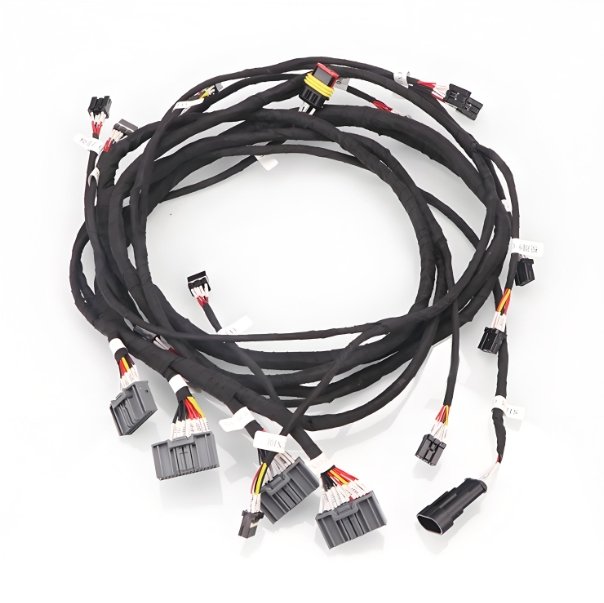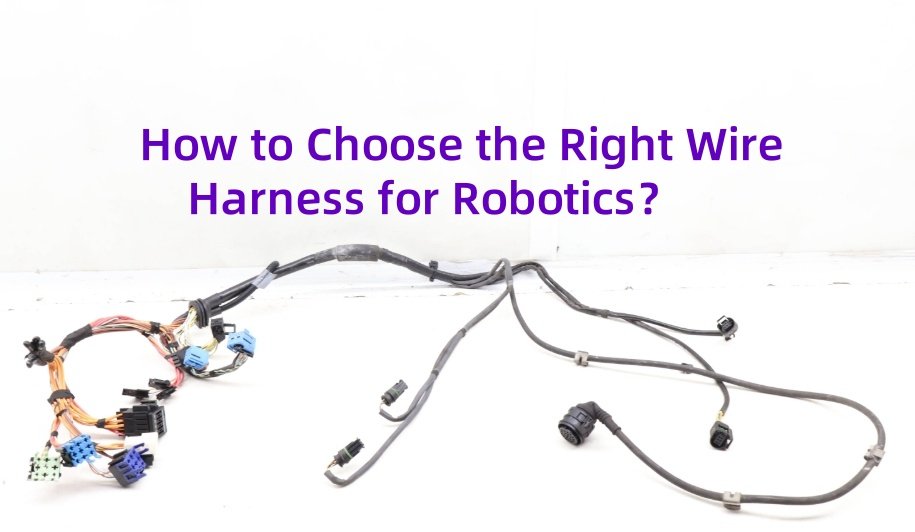Robotics is transforming the way we live and work—powering smart factories, autonomous vehicles, and even household assistants. But have you ever wondered what keeps these sophisticated systems running smoothly? Behind every moving arm and intelligent sensor lies a network of wiring that must be precise and dependable.
The wrong choice of wire harness for robotics can lead to signal loss, mechanical failures, and even safety risks. That’s why selecting the right robotics wiring solutions and custom cable assemblies isn’t just a technical decision—it’s crucial for performance, safety, and the longevity of your robotic systems.
In this blog, I’ll share how to choose the perfect wire harness to ensure your robots operate reliably, whether in industrial automation or consumer applications. Let’s dive in and make your robotics design future-ready.
Why wire harnesses are critical in robotics?
In robotics, the wire harness isn’t just a bundle of cables—it’s the nervous system of the entire machine. Here’s why it’s so important:
1.Power and Signal Transmission
The wire harness carries power, control signals, and data between different components like motors, sensors, controllers, and actuators. Without a reliable harness, the robot simply won’t function.
2.Flexibility for Dynamic Movement
Robots are constantly in motion—bending, twisting, and rotating. The harness must handle continuous flexing without breaking or causing signal loss, which requires specialized high-flex cables.
3.Compact and Efficient Design
Space is often tight inside robotic joints and arms. A well-designed harness organizes cables neatly, reduces clutter, and prevents interference or wear from friction.
4.Resistance to Harsh Environments
Robots often work in demanding conditions—heat, moisture, dust, or chemicals. The harness needs insulation and materials that can endure these environments without degrading.
5.Safety and Reliability
A failure in the wire harness can lead to robot downtime, costly repairs, or even safety hazards. Using high-quality, tested harnesses ensures consistent, safe operation.

Key Factors to Consider When Choosing a Wire Harness
When it comes to selecting the right wire harness for robotics or industrial applications, making the right choice is critical to ensure performance, safety, and long-term reliability. From withstanding harsh environments to meeting complex design requirements, there are many aspects to consider.
To ensure optimal performance in robotics or industrial environments, keep the following 10 key factors in mind when selecting a wire harness:
1.Application Requirements
Understand the specific demands of your system, including electrical load, voltage, and signal types, as well as how and where the harness will be used.
2.Environmental Conditions
Consider temperature extremes, moisture, chemical exposure, vibration, and mechanical stress. The wire harness materials (insulation, coatings) must withstand these conditions to ensure durability and safety.
3.Material Selection
- Conductors: Copper is preferred for its high conductivity; alternatives like tinned or silver-plated copper may be used for corrosion resistance.
- Insulation: PVC and rubber suit general use, while PTFE or fluoropolymers are better for high-temperature or chemically aggressive environments.
5.Connectors
Choose connectors compatible with wire gauge and electrical/mechanical requirements. They should facilitate easy assembly/disassembly and maintain secure, stable connections under vibration and movement.
6.Size, Shape, and Routing
The harness design must fit the space constraints and allow for proper routing to avoid sharp bends or stress points that could cause failure.
7.Standards and Certifications
Ensure compliance with industry standards such as UL, RoHS, ISO, or MIL-spec, depending on the application, to guarantee safety and quality.
8.Customization vs. Pre-Made
Complex or unique applications often require custom harnesses tailored to specific needs for optimal performance.
9.Manufacturer Expertise
Partner with experienced manufacturers who provide quality materials, craftsmanship, and support to meet your technical and regulatory requirements.
10.Cost-Effectiveness
Balance design complexity and material quality to optimize performance while controlling costs and minimizing waste.
These factors collectively ensure that the wire harness will reliably transmit power and signals, withstand operational stresses, and contribute to the overall efficiency and longevity of the robotic system or industrial equipment.
How do I determine the right wire gauge for my robot’s power and signal needs?
When I’m designing a wire harness for robotics, selecting the right wire gauge is one of the most critical steps. If the wire is too thin, it can overheat, cause voltage drops, or even fail under load. If it’s too thick, it adds unnecessary bulk and reduces flexibility—something you don’t want in tight robotic joints.
1.Determining Wire Gauge for Power Needs
Calculate Maximum Current
Identify the highest current (in amps) that each wire will carry. This is typically found in the device datasheets or manuals.
Consider Allowable Voltage Drop
Decide the maximum voltage drop acceptable for your application. For critical systems, keep voltage drop below 3%; for general use, up to 5% is acceptable.
Measure Wire Length
Longer wires increase resistance and voltage drop. Measure the distance from the power source to the load.
Consult Wire Gauge Charts
Use the calculated current and length to reference a wire gauge chart. For example:
- 10 AWG: Suitable for high-current motors (up to 30-40A for short runs)
- 12 AWG: Used for circuits up to 20A
- 14 AWG: For circuits up to 15A
Add a Safety Margin:
Choose a wire gauge one size larger than calculated to ensure safety and account for unforeseen loads
Example Rule of Thumb:
| Current (A) | Max Length (m) | Recommended Gauge |
| Up to 3 | 1–2 | 22 AWG |
| Up to 10 | 1–2 | 18 AWG |
| Up to 20 | 1–2 | 14 AWG |
| 30–40 | 1–2 | 10–8 AWG |
2.Determining Wire Gauge for Signal Needs
Low Current, Short Runs:
For most signal wires (logic, sensors), 26–28 AWG is typical, as these carry minimal current.
Long Runs or Sensitive Signals:
If the signal wires are long or connect sensitive analog sensors, consider using thicker wires (e.g., 24 AWG) to reduce resistance and minimize voltage drop or interference.
Shielded Cable:
For environments with electrical noise, use shielded cables to protect signal integrity.
Signal Wire Rule of Thumb:
| Application | Recommended Gauge |
| Digital signals | 28 AWG |
| Analog signals | 26–24 AWG |
| Low-current devices | 26–24 AWG |
3.Additional Considerations
Wire Type:
Use stranded wire for flexibility and vibration resistance in robots; avoid solid wire except for stationary applications.
Material:
Copper is standard for conductivity and durability.
Environment:
Adjust gauge and insulation type for high-temperature, chemical, or high-flex environments.
Circuit Protection:
Ensure the wire gauge is compatible with fuses or circuit breakers to prevent overheating
Summary Table: Quick Reference
| Function | Typical Gauge | Notes |
| Power (motors, actuators) | 10–18 AWG | Larger currents need thicker wires |
| Signal (logic, sensors) | 24–28 AWG | Short runs, low current |
| Long runs/high current | 12–14 AWG | Reduce voltage drop, improve reliability |
Practical Example
For a robot drive motor drawing 30A over a 1-meter run, use at least 10 AWG wire. For a sensor signal line, 26–28 AWG is usually sufficient if the run is under 2 meters.

How do I choose between standard and custom wire harnesses for a robotics project?
When choosing between standard and custom wire harnesses for a robotics project, consider the following 6 key factors:
| Aspect | Standard Wire Harnesses | Custom Wire Harnesses |
| Fit and Design | Pre-made, generic sizes and configurations; may require modifications to fit your robot | Tailored exactly to your robot’s specifications, including wire length, connectors, and routing |
| Performance & Reliability | Suitable for general applications but may not meet specific environmental or mechanical demands | Designed with materials and insulation to withstand specific conditions like temperature, vibration, and chemical exposure, enhancing durability |
| Installation Time | May need adjustments or rework during installation, increasing time and risk of errors | Plug-and-play design reduces installation time and minimizes mistakes |
| Cost | Lower upfront cost and readily available | Higher initial cost due to design and manufacturing but can reduce long-term costs by improving reliability and reducing maintenance |
| Flexibility & Scalability | Limited flexibility for unique or complex robotic designs | Highly flexible, can accommodate complex routing, multiple branches, and integration with advanced robotic systems |
| Application Complexity | Best for simple, standard robotic systems or prototypes | Ideal for advanced, high-performance, or harsh-environment robotics requiring precise wiring solutions |
Why Choose Custom Wire Harnesses for Robotics?
- Robotics often involves repetitive motion, tight spaces, and harsh environments that standard harnesses may not withstand reliably. Custom harnesses use specialized materials and designs to handle these challenges effectively.
- Custom harnesses ensure perfect integration with your robot’s components, improving signal integrity, power delivery, and overall system efficiency.
- They reduce installation time and errors by being pre-configured to your exact needs, which is crucial in complex robotic assemblies.
- While costlier upfront, custom harnesses can save money over time by reducing downtime, maintenance, and replacements.
When to Choose Standard Wire Harnesses?
When your project is simple, low volume, or a prototype where cost and speed are priorities over perfect fit or durability.
If your robot operates in a controlled environment without extreme conditions or complex wiring needs.
When you need a quick solution and the standard harness meets your electrical and mechanical requirements.
Final Thoughts:
For most industrial and advanced robotics applications—especially those operating in demanding environments, requiring intricate wiring, or aiming for long-term reliability—a custom wire harness is often the smartest investment. Custom solutions deliver the precise performance, durability, and simplified installation that off-the-shelf harnesses simply can’t provide.
That said, for smaller-scale or budget-sensitive projects, a standard harness can still be a practical option as long as it meets the core technical requirements.
Taking a balanced approach allows you to optimize cost, performance, and reliability to ensure your robotics wiring system supports your project’s success.
What are high-flex cables and why are they essential for robotics applications?
High-flex cables are specialized cables designed to withstand continuous bending, twisting, and dynamic movement without failure, making them essential for robotics applications where cables must move repeatedly and flexibly with robotic joints and arms.
What Are High-Flex Cables?
They are built with flexible conductor materials (often finely stranded copper alloys) and insulation/jackets that resist deformation and damage from constant motion.
Their construction allows conductors to move freely inside the cable without breaking, and their jackets are designed to resist abrasion, chemicals, and temperature extremes.
High-flex cables can endure millions of bending and torsion cycles, far surpassing standard cables in durability.
Why Are High-Flex Cables Essential for Robotics?
- Continuous Movement: Robots perform repetitive, complex motions involving bending, twisting, and rolling of cables. High-flex cables maintain electrical and mechanical integrity under these stresses, preventing failures that could halt operation.
- Signal and Power Reliability: They ensure consistent transmission of power and data signals despite constant motion, which is critical for precise robotic control and safety.
- Extended Service Life: High-flex cables reduce downtime and maintenance costs by resisting wear, abrasion, and fatigue much longer than standard cables.
- Environmental Resistance: Many high-flex cables are designed to withstand harsh industrial environments, including exposure to oils, chemicals, UV radiation, and temperature fluctuations common in robotic settings.
- Space Efficiency: Some high-flex cables come in flat or compact designs that allow tight bending radii and efficient routing in confined robotic spaces.
How important is EMI shielding in robotic wire harnesses?
EMI shielding is extremely important in robotic wire harnesses because it protects sensitive electronic signals from electromagnetic interference (EMI) that can cause signal degradation, data corruption, or malfunction of robotic systems.
Why EMI Shielding Matters in Robotics?
- Ensures Signal Integrity: EMI shielding creates a conductive barrier around wires, preventing external electromagnetic noise from disrupting power and data signals critical for robot control and communication.
- Prevents Data Loss and Malfunction: Industrial robots operate in environments with high electrical noise from motors, controllers, and other equipment. Without shielding, EMI can cause errors, reducing system reliability and safety.
- Protects Against Radiated Emissions: Shielding also prevents the robot’s own wiring from emitting EMI that could interfere with nearby devices or other parts of the robot.
- Supports Harsh Industrial Environments: Robotics often operate amid vibration, dust, and temperature extremes. Effective shielding materials and proper grounding ensure stable operation under these conditions.
- Maintains High-Speed Data Transmission: For robots relying on fast data communication (e.g., Ethernet, sensors), shielding reduces noise and interference, enabling consistent performance.
How EMI Shielding Works?
A metallic shield (braided copper mesh, aluminum foil, or conductive polymer) surrounds the wires, grounded to safely dissipate interference.
This acts like a Faraday cage, reflecting or absorbing electromagnetic waves to block interference from entering or leaving the cable bundle.
Proper installation includes secure connections between the shield and connectors to maintain continuous protection
EMI shielding in robotic wire harnesses is critical for maintaining the reliability, accuracy, and safety of robotic systems, especially in industrial environments with high electromagnetic noise. It prevents signal disruptions that can lead to costly downtime, errors, or equipment damage, making it an essential design consideration for any robotics project.

What testing should a wire harness undergo to ensure quality for robotics use?
To ensure quality and reliability for robotics use, a wire harness should undergo comprehensive testing covering mechanical, electrical, environmental, and functional aspects:
1.Electrical Testing
- Continuity Test: Verifies all wires are properly connected with no breaks.
- Insulation Resistance Test: Measures insulation integrity to prevent leakage currents and short circuits.
- High-Voltage (Hipot) Test: Applies high voltage to detect insulation breakdown or weak points.
- Contact Resistance Test: Ensures low resistance at connectors and crimps for efficient conductivity.
- Short Circuit Test: Detects any unintended connections that could cause faults.
- End-to-End Functional Test: Simulates real operation to verify power flow, signal integrity, and data transmission.
2.Mechanical Testing
- Flex & Bend Test: Simulates repetitive bending and movement to check wire fatigue resistance, critical for robotic joints and arms.
- Tensile Strength Test: Applies pulling force to verify connector and crimp strength.
- Vibration Test: Mimics operational vibrations to ensure connector retention and wire integrity.
- Pull-Out Force Test: Measures force needed to disconnect terminals, ensuring secure connections.
- Bending & Rotating Tests: Includes 90° and 180° bending, torsion (2D and 3D), and rapid bending cycles to simulate robotic motion stresses.
3.Environmental Testing
- Temperature Cycling: Tests performance under rapid temperature changes to ensure thermal stability.
- Salt Spray Test: Assesses corrosion resistance, important for harsh or outdoor environments.
- Waterproof/IP Rating Test: Confirms protection against moisture and water ingress (e.g., IP67/IP68).
- Chemical Resistance: Evaluates durability against oils, fuels, and industrial chemicals common in robotic settings.
4.Functional & Final Inspection
- Connector Engagement/Disengagement: Ensures connectors mate securely and can be disconnected without damage.
- Visual and Dimensional Inspection: Checks for assembly defects, proper wire routing, and compliance with design specifications.
- Compliance with Standards: Adherence to industry standards such as IPC/WHMA-A-620, IEC 60227-6, ISO 14572 ensures quality and reliability.
Can I use overmolded wire harnesses in dynamic robotic applications?
Yes, overmolded wire harnesses can be used effectively in dynamic robotic applications and are often preferred due to their enhanced durability and protection.
Overmolded wire harnesses are designed to withstand the mechanical stresses and harsh environmental conditions typical of robotics, making them an excellent choice for dynamic robotic applications. Their combination of protection, flexibility, vibration resistance, and improved electrical performance ensures reliable and long-lasting operation in demanding robotic systems.
Why Overmolded Wire Harnesses Are Suitable for Robotics?
- Superior Protection: Overmolding encapsulates wires and connectors in a durable plastic or rubber layer, providing a watertight seal that protects against moisture, dust, chemicals, abrasion, and physical impact—common challenges in robotic environments.
- Increased Flexibility and Strain Relief: The overmolded layer offers 360-degree strain relief around connectors and cable junctions, reducing mechanical stress from bending, twisting, and pulling. This flexibility is crucial in robotics, where cables experience continuous movement.
- Enhanced Vibration Resistance: Overmolding absorbs shocks and vibrations typical in robotic operations, preventing wire fatigue and connector failures, thus improving reliability and lifespan.
- Improved Electrical Performance: Overmolding provides additional insulation and can help reduce electromagnetic interference (EMI), which is important for maintaining signal integrity in complex robotic systems.
- Streamlined Assembly and Aesthetics: Overmolded harnesses consolidate multiple wires into a compact, organized unit that is easier to install and maintain, reducing clutter and improving the professional appearance of robotic assemblies.
How to Select the Right Wire Harness Supplier?
Choosing the right wire harness supplier is critical to ensure your robotics or industrial automation projects run reliably and safely. A good partner doesn’t just deliver products—they provide expertise, quality, and long-term support. Here’s what to look for:
1.Industry Experience and Expertise
Look for suppliers with proven experience in your field. For robotics, they should understand the demands of flexibility, precision, and high-performance wiring solutions.
2.Customization Capabilities
If your application requires custom cable assemblies, choose a supplier who can design and manufacture to your exact specifications—including special connectors, materials, and certifications.
3.Certifications and Quality Standards
Ensure they comply with standards like ISO 9001, UL, and IATF 16949 for automotive and industrial applications. This guarantees consistent quality and safety.
4.Advanced Testing Processes
Your supplier should provide 100% tested harnesses for continuity, insulation, and durability to avoid failures in the field.
5.Flexibility and Support
Can they handle both low-volume prototypes and high-volume production runs? Do they offer engineering support and fast lead times?
6.Competitive Pricing and ROI
Price matters, but so does value. The cheapest harness isn’t always the best if it compromises performance or leads to downtime.
At Yihetai, we know your robotics application deserves wiring that performs flawlessly. With 25+ years of experience and end-to-end production capabilities, we create custom wire harnesses that meet the highest standards. Get in touch now and see how we can support your success.
Conclusion:
Choosing the right wire harness for robotics isn’t just a technical detail—it’s a crucial decision that impacts your robot’s performance, safety, and longevity. From managing complex movements to withstanding demanding environments, the right custom cable assemblies ensure your robotic systems operate flawlessly.
At Yihetai, I’ve seen how our expertise in robotics wiring solutions helps engineers like you overcome challenges and bring innovative designs to life. Whether you need high-flex harnesses for dynamic applications or compact solutions for tight spaces, we can deliver wiring systems tailored to your exact requirements.
Let’s make your robotics projects more reliable and efficient. Contact our experts to discuss your robotics wiring needs today. info@yihetai-cable.com


